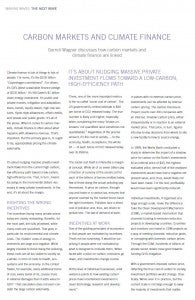 Climate finance is lots of things to lots of people. For some, it’s the $100 billion “Copenhagen commitment”. For others, it’s Citi’s latest sustainable finance pledge of $100 billion. It’s Bill Gates’s $1 billion clean energy investment. It’s public and private monies; mitigation and adaptation; loans, bonds, equity stakes, high-risk ventures, Kyoto-style allowances, offset credits, and private and public grants. It’s all of the above. When it comes to carbon markets, climate finance is often about what happens with allowance revenue. That’s important. But the primary goal is, or ought to be, appropriately pricing the climate externality.
Climate finance is lots of things to lots of people. For some, it’s the $100 billion “Copenhagen commitment”. For others, it’s Citi’s latest sustainable finance pledge of $100 billion. It’s Bill Gates’s $1 billion clean energy investment. It’s public and private monies; mitigation and adaptation; loans, bonds, equity stakes, high-risk ventures, Kyoto-style allowances, offset credits, and private and public grants. It’s all of the above. When it comes to carbon markets, climate finance is often about what happens with allowance revenue. That’s important. But the primary goal is, or ought to be, appropriately pricing the climate externality.
It’s about nudging massive private investment flows from the current high-carbon, low-efficiency path toward a low-carbon, high-efficiency one. That, in turn, means focusing on the incremental dollars necessary to sway private investments. In the end, it’s all about the margin.
Righting the wrong incentives
The incentives facing many private actors today are clearly misleading. Benefits, for the most part, are fully privatised, while many costs are socialised. That goes in particular for environmental and climate costs. The ‘hidden’ costs of energy investments are large and negative. While largely invisible to those doing the polluting, these costs are all too visible to society as a whole: in form of costs to health, ecosystems, and the economy. In the United States, for example, every additional tonne of coal, every barrel of oil, causes more in external damages than it adds value to GDP. That calculation does not even consider the large carbon externality.
There, one of the more important metrics is the so-called ‘social cost of carbon’. The US government’s central estimate is $40 per tonne of CO2 released today. The true number is likely a lot higher, especially when considering the many ‘known unknowns’ not quantified (and sometimes not quantifiable). Regardless of the precise amount, it’s the cost to society — to the economy, health, ecosystems, the whole lot — of each tonne of CO2 released today over its lifetime.
The social cost itself is inherently a marginal concept. While all of us seven billion pay a fraction of a penny of the social cost for each of the billions of tonnes emitted today, few of those doing the actual polluting pay themselves. A price on carbon, through cap and trade or a carbon tax, ensures that anyone covered by the market forces faces the right incentives. Polluters face a direct cost of pollution and, thus, are driven to pollute less. The law of demand at work.
Incentives at work
One of the guiding principles of economics is that people are motivated by incentives. That’s not too surprising. It would be surprising if people were not motivated by what is designed to motivate them. When faced with a price on carbon, emissions go down, and investments change course.
At the level of individual businesses, solid evidence points to how existing carbon prices have incentivised investment in clean technology, research and development.
In places with no external carbon price, investments can be affected by internal carbon pricing. The Carbon Disclosure Project counts over 400 companies with an internal, ‘shadow’ carbon price, either independently or in reaction to an external market price. That price, in turn, figures into day-to-day decisions from where to site a new facility to how to source energy.
In 1999, the World Bank conducted a study to determine the impact of a shadow price for carbon on the Bank’s investments. At an internal price of $40, the highest evaluated price, almost half of the analysed investments would have had a negative net present value, and, thus, would likely not have been made. For the rest, profitability would have been significantly reduced.
Individual investments, if organised at a large enough scale, make the difference. Take the Clean Development Mechanism (CDM), a market-based mechanism that channels funding to emission reduction projects in developing countries. Countries and investors can invest in CDM projects as a way of meeting domestic reduction goals, or complying with domestic carbon prices. Through the CDM, hundreds of billions of private sector dollars have gone towards funding GHG mitigation.
With a government-imposed carbon price, reflecting the true cost of carbon to society, investment portfolios would change. Drastically. We’ve seen it in practice, but the current scale is not large enough to sway the majority of investments that matter. Today, in fact, much of firms’ investments towards mitigating climate change are made voluntarily.
From Climate Finance to Finance
Climate finance often is ‘concessional’ finance. That might be outright development aid. It also includes voluntary commitments like Citi’s $100 billion. Citi, of course, is not alone. Goldman Sachs committed $40 billion in 2012, Bank of America $50 billion in 2013, all made over 10 years. Meanwhile, these three banks alone underwrite hundreds of billions of loans every year. Total global Foreign Direct Investment is in the trillions.
These massive financial flows won’t be redirected overnight. But they do follow incentives. In fact, that’s all they follow.
Enter carbon markets. They ensure that anyone covered by the market faces the right incentives. The prevailing allowance price is one good proxy of the level of ambition of any particular market. It’s also what helps nudge investments into the right direction. In econ-speak, it’s all about internalising externalities. In English, it’s about paying your fair share and no longer socialising costs.
None of that renders what’s traditionally called ‘climate finance’ unnecessary. There are still plenty of uses for additional monies. In particular, carbon markets are all about mitigation. Adaptation might dovetail nicely on some forms of mitigation, but it’s not the primary goal. That’s where foreign aid as well as government and private grants come in. If anything, those amounts need to be scaled up, too.
But the true scaling happens on the investment front. That’s no longer “climate finance.” It’s simply “finance.” Re-channelling only 0.1% of total wealth under active management globally amounts to around a $100 billion shift. Efforts, of course, must not stop there. It’s about channelling the full $100 trillion into the right direction.
Gernot Wagner is lead senior economist at the Environmental Defense Fund, and co-author, with Harvard’s Martin L. Weitzman, of Climate Shock (Princeton University Press, 2015).
This article was first published in IETA’s Greenhouse Gas Market 2015 report “Making Waves“. Download the full text in PDF form.













